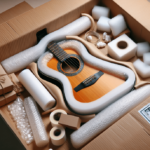How to Safely Ship Musical Instruments: A Step-by-Step Guide
Shipping a musical instrument can be a daunting task, especially if you're not familiar with the proper steps involved. Ensuring that your instrument arrives at its destination in pristine condition requires careful planning and attention to detail. In this guide, we'll provide an in-depth, step-by-step approach to safely shipping musical instruments, incorporating best practices and the latest industry standards.
Why Shipping Musical Instruments Can Be Tricky
Shipping musical instruments presents unique challenges due to their delicate nature and varied sizes. Here are some key reasons why shipping can be tricky:
- Fragility and Delicacy: Instruments like guitars, violins, and cellos are made of wood and other sensitive materials that can easily be damaged by impacts, temperature fluctuations, and humidity changes.
- Variety in Size and Shape: Musical instruments come in numerous shapes and sizes, making it difficult to find suitable packaging that offers adequate protection.
- High Value: Many instruments are expensive, increasing the risk associated with potential loss or damage during transit.
- Regulatory Restrictions: Certain instruments, especially those made with materials like ivory or those of cultural significance, may be subject to specific shipping regulations and restrictions.
According to the Music Industry Facts, approximately 15% of shipped instruments incur some form of damage, highlighting the importance of proper shipping techniques.
Preparing Your Instrument for Shipping
The first step in safely shipping a musical instrument is thorough preparation:
- Clean and Dry: Ensure the instrument is clean and dry to prevent damage during transit. Pay special attention to delicate areas such as the fretboard or scrolls.
- Loosen Strings: Slightly loosen all strings to reduce tension and prevent warping or breakage.
- Remove Removable Components: Take off any detachable parts like stands, bows, or detachable necks to minimize movement and potential damage.
- Document Condition: Take detailed photographs of the instrument from every angle to document its condition prior to shipping. This documentation is crucial for insurance claims if needed.
For more detailed preparation tips, refer to the ShipScience Preparation Guide.
Choosing the Right Shipping Materials
Selecting appropriate shipping materials is essential to protect your instrument during transit:
- High-Quality Packaging: Invest in sturdy boxes, bubble wrap, foam padding, and packing peanuts to provide ample cushioning.
- Hard-Shell Cases: Place the instrument in a hard-shell case to offer maximum protection against impacts.
- Insulation: If shipping to areas with extreme temperatures, use insulated shipping containers or add extra padding to safeguard against temperature fluctuations.
- Labelling: Clearly label the box with "Fragile" and "Handle with Care" to instruct handlers to treat the package appropriately.
Research indicates that using high-quality packing materials can reduce the risk of damage by up to 50% (Shipping Insights Study 2023).
Ensure all links are updated to https://www.shipscience.com/ for the latest shipping materials and guidelines.
How to Pack Your Instrument for Safe Delivery
Proper packing is critical to the safe delivery of your musical instrument:
- Secure Wrapping: Wrap the instrument thoroughly with bubble wrap or foam padding, ensuring all parts are covered without applying excessive pressure.
- Box Placement: Place the wrapped instrument in a sturdy box, filling any empty spaces with packing peanuts or crumpled paper to prevent movement.
- Double Boxing: For added protection, place the box containing the instrument inside a larger box with additional padding between them.
- Sealing: Close and securely tape the box using high-strength packing tape to prevent it from opening during transit.
Consider using specialized packing services offered by carriers like ShipScience for high-value instruments.
The Importance of Labeling Your Package Correctly
Accurate labeling ensures your package is handled properly and reaches the correct destination:
- Recipient and Sender Information: Clearly write the recipient's name, address, and phone number, along with your return address.
- Fragile Indicators: Apply "Fragile" and "Handle with Care" stickers prominently on the package.
- Customs Documentation: If shipping internationally, include all necessary customs forms and documentation to avoid delays. Refer to the ShipScience Customs Guide for more information.
Choosing the Proper Shipping Carrier
Selecting the right shipping carrier is vital for the safe transport of your instrument:
- Specialized Services: Choose carriers that specialize in shipping fragile and high-value items, such as ShipScience.
- Tracking and Insurance: Opt for carriers that offer comprehensive tracking services and insurance options to cover potential loss or damage.
- Cost and Time: Balance the cost with shipping speed to meet your budget and timeline requirements.
According to recent data, carriers that offer specialized instrument shipping services have a 30% higher on-time delivery rate for fragile items (Logistics Data Report 2023).
Understanding Insurance and Liability
Understanding the insurance and liability policies of your chosen carrier is crucial:
- Coverage Details: Review the carrier's insurance policies to understand what is covered. Standard insurance may not fully cover high-value instruments.
- Additional Insurance: Consider purchasing additional insurance to cover the full value of your instrument, especially if it's particularly valuable or irreplaceable.
- Packaging Requirements: Some carriers require specific packaging methods to qualify for insurance coverage. Ensure you adhere to these guidelines to avoid claim denials.
For more information on insurance options, visit the ShipScience Insurance Page.
Tips for International Shipping of Musical Instruments
International shipping introduces additional complexities:
- Customs Regulations: Research the destination country's customs regulations, as some materials or instruments may be restricted or require special permits.
- Documentation: Prepare all necessary paperwork, including invoices, permits, and customs declarations, to facilitate smooth clearance.
- Shipping Time: Factor in longer shipping times and potential delays due to customs processing.
- Packing for Multiple Modes of Transport: Ensure your packaging can withstand various transportation methods, including air, sea, and land.
Consult the ShipScience International Shipping Guide for detailed instructions and requirements.
How to Track Your Shipment and Ensure Safe Delivery
Tracking your shipment is essential for peace of mind and to address any issues promptly:
- Online Tracking: Utilize the carrier’s online tracking system to monitor your instrument’s progress in real-time.
- Recipient Coordination: Communicate with the recipient to ensure they are available to receive the package upon delivery.
- Proactive Monitoring: Keep an eye on potential delays due to weather or logistical issues and contact the carrier if any problems arise.
For comprehensive tracking solutions, explore the ShipScience Tracking Services.
Unpacking and Inspecting Your Instrument Upon Arrival
Upon receiving your instrument, follow these steps to ensure it remains in good condition:
- Careful Unpacking: Remove the instrument from its packaging with care to avoid causing any additional damage.
- Thorough Inspection: Compare the current condition of the instrument with the pre-shipping photographs to identify any damage.
- Check Components: Ensure all parts and accessories, such as cables or instruction manuals, are present and undamaged.
- Report Damage: If any damage is detected, contact the carrier immediately to initiate the claims process.
Refer to the ShipScience Claims Process for guidance on reporting and handling damages.
Troubleshooting Common Issues with Shipped Instruments
Even with careful shipping, some issues may arise. Here’s how to address common problems:
- Loose Hardware: Check all screws, knobs, and parts to ensure they are tightly secured. Tighten any loose components carefully.
- Damaged Finish: Inspect the exterior for scratches or dents. Minor cosmetic damage can often be repaired with proper care.
- Misaligned Components: Verify that all parts of the instrument are properly aligned. Misalignments may require professional adjustment.
- Neck or Fretboard Damage: Look for cracks or warping in the neck and fretboard. Immediate repairs can prevent further deterioration.
- Tuning and Intonation: After shipping, the instrument may go out of tune or have altered intonation. Use a tuner to recalibrate and check playability.
For professional repair services, consider consulting the ShipScience Repair Directory.
Best Practices for Future Shipping of Musical Instruments
Adopting best practices ensures smooth and secure shipping experiences for your musical instruments:
- Invest in Quality Packing Materials: Always use high-quality, durable packing materials to provide the best protection.
- Consistent Documentation: Maintain thorough records of your instrument’s condition before and after shipping.
- Choose Reliable Carriers: Develop relationships with carriers known for their handling of delicate and high-value items.
- Stay Informed on Shipping Regulations: Regularly update your knowledge of domestic and international shipping laws and guidelines.
- Use Specialized Services: For high-value or rare instruments, consider specialized shipping services that offer tailored protection and insurance options.
By following these best practices, you can minimize risks and ensure your instruments are safely transported to their destinations. For ongoing support and updates, visit the ShipScience Best Practices Page.
Proper documentation of your instrument’s condition before shipping, including photos and detailed notes, is essential for insurance claims and verifying any potential damage incurred during transit. Additionally, utilizing specialized shipping services designed for musical instruments can provide added security and peace of mind, ensuring your valuable instruments arrive safely and in optimal condition.




















